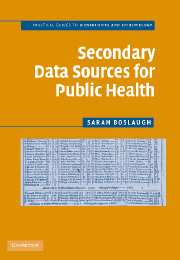Book contents
- Frontmatter
- Contents
- Preface
- Acknowledgments
- 1 An Introduction to Secondary Data Analysis
- 2 Health Services Utilization Data
- 3 Health Behaviors and Risk Factors Data
- 4 Data on Multiple Health Topics
- 5 Fertility and Mortality Data
- 6 Medicare and Medicaid Data
- 7 Other Sources of Data
- Appendix I Acronyms
- Appendix II Summary of Data Sets and Years Available
- Appendix III Data Import and Transfer
- Bibliography
- Index
2 - Health Services Utilization Data
Published online by Cambridge University Press: 03 December 2009
- Frontmatter
- Contents
- Preface
- Acknowledgments
- 1 An Introduction to Secondary Data Analysis
- 2 Health Services Utilization Data
- 3 Health Behaviors and Risk Factors Data
- 4 Data on Multiple Health Topics
- 5 Fertility and Mortality Data
- 6 Medicare and Medicaid Data
- 7 Other Sources of Data
- Appendix I Acronyms
- Appendix II Summary of Data Sets and Years Available
- Appendix III Data Import and Transfer
- Bibliography
- Index
Summary
This chapter discusses twelve sources of data about health services utilization at the state, regional, or national level in the United States. The title National Health Care Survey (NHCS) actually refers to eight surveys conducted under the auspices of the National Center for Health Statistics (NCHS): the National Ambulatory Medical Care Survey (NAMCS), the National Hospital Ambulatory Medical Care Survey (NHAMCS), the National Hospital Discharge Survey (NHDS), the National Nursing Home Survey (NNHS), the National Health Provider Inventory (NHPI), the National Survey of Ambulatory Surgery (NSAS), the National Home and Hospice Care Survey (NHHCS), and the National Employer Health Insurance Survey (NEHIS). Three other surveys are also discussed. The Healthcare Cost and Utilization Project (HCUP) is a family of databases created from discharge records from community hospitals and ambulatory surgery sites. The Medical Expenditures Panel Survey (MEPS) collects data on health care utilization and costs and insurance coverage, and uses an overlapping panel design for the household portion of the survey so data on each participating household are available for 2 full years. The National Immunization Survey (NIS) collects data on immunization rates for children ages 19 to 35 months, whenever possible, from both the child's parent or other adult household member and their vaccination provider(s). The Surveillance Epidemiology and End Results (SEER) program collects information on cancer incidence, treatment, and survival from a number of population-based cancer registries in the United States, including demographic information about individual patients.
Information
- Type
- Chapter
- Information
- Secondary Data Sources for Public HealthA Practical Guide, pp. 12 - 33Publisher: Cambridge University PressPrint publication year: 2007
